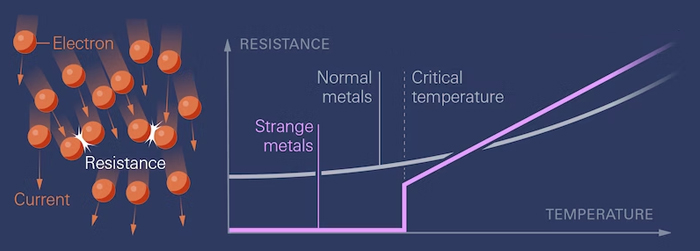Physicists have provided an elegant solution to the 37-year-old problem of why 'strange metals' conduct electricity in exotic ways.
This universal theory might help scientists design better superconductors for quantum computers, says physicist and co-author Aavishkar Patel.
Strange metals behave in odd ways when electricity passes through them. At very low temperatures, these metals become superconductors, meaning that they have zero resistance to the flow of electrons.
Resistance typically increases for all materials at higher temperatures because electrons are more energized and bump into each other more frequently.
Counterintuitively, strange metals are even more resistant to the flow of electrons than ordinary metals at higher temperatures, even though they are superconductors at low temperatures.
As the strange metal warms, it hits a critical temperature where the resistance increases suddenly. Beyond this point, resistance increases in proportion to temperature, which can be represented as a straight line trending upwards on a graph.
Ordinary metals like iron and copper don't behave this way. In ordinary metals, the resistance increases with the square of the temperature, which, once graphed, looks like a gently sweeping curve.

What causes this weird behavior? It's a combination of quantum entanglement and randomness, according to Patel, who works at the Flatiron Institute in New York, and colleagues from several other universities across the US.
Alone, these properties can't explain the quirks of strange metals, but together, "everything just falls into place," says Patel.
Entanglement describes correlations between particles that give them a sort of shared identity. In materials like strange metals, pairs of entangled electrons called Cooper pairs have wave-like properties that at low temperatures help them slip more easily through a forest of atoms.
Yet the arrangement of atoms inside strange metals is also relatively random. Cooper pairs distributed irregularly through the material are less likely to flow in the same direction as the temperature rises, randomising their momentum in a way that causes additional resistance as they jostle.
"This interplay of entanglement and nonuniformity is a new effect; it hadn't been considered ever before for any material," says Patel.
"In retrospect, it's an extremely simple thing. For a long time, people were making this whole story of strange metals unnecessarily complicated, and that was just not the right thing to do."
The bizarre behavior of strange metals was first discovered in ceramic crystals called cuprates in 1986. The scientists who synthesized this material, physicists Georg Bednorz and Alex Müller, were awarded a Nobel Prize for their efforts.
At the time, this synthetic cuprate was the highest-temperature superconductor ever created, and it sparked a search for more materials with these properties – a quest that continues to this day.
Today, we have many superconducting materials, but they only work at extremely low temperatures achieveable using bulky, expensive materials and infrastructure, making them impractical for wide-scale use.
Making strange metals less strange could be a significant step towards the creation of highly efficient, resistant-free circuits that operate under more ambient conditions.
"I would like to call them unusual metals at this point, not strange," says Patel.
The study was published in Science.
